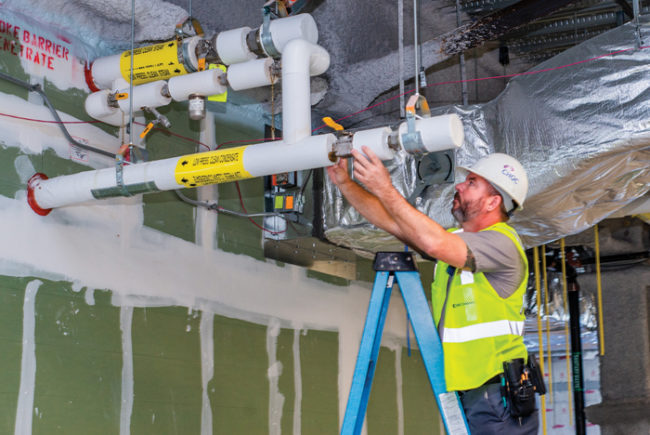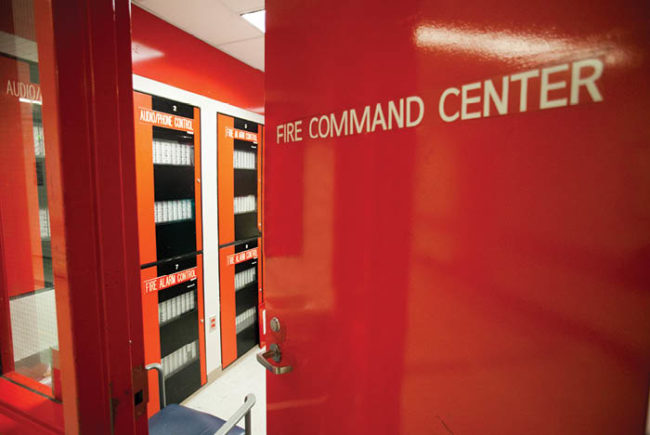 |
|
Photo by Istock Multiple authorities having jurisdiction enforce compliance with a variety of codes. |
Health care facilities are subject to many codes, standards and regulations, with each enforced by multiple authorities having jurisdiction (AHJs). The primary AHJ for a hospital is the Centers for Medicare & Medicaid Services (CMS).
Although dominating the hospital construction landscape through adoption of the National Fire Protection Association’s NFPA 101, Life Safety Code; other AHJs such as local and state governments also have a say in the construction of hospital buildings.
Coordinating codes
Local building officials, fire marshals and state building oversight primarily use the International Code Council’s (ICC’s) family of model codes, including the International Building Code (IBC) and the International Fire Code (IFC). Although similar, the code development process for each of those distinct publications has moved in separate directions. The differences may seem very slight and technical, but they have profound impacts on a hospital, which needs to satisfy the requirements of multiple AHJs to open new buildings or renovation projects.
You may also like |
| Coordinating advocacy efforts for hospitals |
| Reality-based building codes |
| An update on ASHE’s codes efforts |
| |
Although officially considered voluntary participation with CMS, compliance with its rules and regulations is the way hospitals receive reimbursement through those government entitlement programs. Therefore, the vast majority of the hospitals across the country follow CMS regulations, including the building and maintenance requirements of hospitals. This direct tie to funding gives the Life Safety Code a primary role in the built environment for a hospital.
The Joint Commission, the key accrediting organization that deems status of CMS compliance for hospitals, bases its life safety regulations directly on the Life Safety Code. The importance of the Life Safety Code cannot be overstated. For new construction, designers follow the “New Health Care Occupancies” chapter, while facilities managers use the “Existing Health Care Occupancies” chapter for ongoing operations, and CMS uses the “existing” chapter to verify compliance so the facility can receive CMS funding.
At the same time, any building is part of a local jurisdiction, whose fire marshal and building officials are equally concerned with the safety of the occupants of the building: patients, staff and visitors alike. Local building inspectors use the IBC to review and inspect new construction, and local and state fire marshals heavily use the IFC in more routine fire safety inspections in all buildings. The rough equivalent of that concept exists in the Life Safety Code as the “new” and “existing” sections. With all of the attention a hospital building receives from multiple jurisdictions, the health care building type becomes the most highly regulated.
Often, these jurisdictions operate separately from each other, especially the federal and local inspectors. States often find themselves in a unique situation, because it is not unusual for a state to inspect hospitals on behalf of the federal government. States also adopt the model codes for their own governmental buildings, and to interface better with localities. When entering a health care facility, there is the potential of reviewing the building under the Life Safety Code for the federal government one day, and coming in the next day to review the building under the IFC or IBC. What is acceptable one day, is a violation the next. Keeping up with these conflicts can be time-consuming and expensive in both the new construction and facility maintenance settings.
Generally, state departments of health have a solid grasp of the health care building type. Due to the built-in working relationship with the patient care portions of the department of health, a state department of health plan review and building inspection office is positioned to have a closer relationship with the hospital. In some instances, local governments are keenly aware of this unique relationship, and treat the hospital building type in a unique way.
The locality will not review until the design has state department of health approval, primarily based on the Life Safety Code. This is to ensure that the health care portions are reviewed by the state, leaving the IBC aspects to the local jurisdiction, including accessibility, high-rise requirements, exiting and occupancy. Conversely, when the individual jurisdictions do not coordinate their review, approval and occupancy processes, it can lead to a perfect storm of contradiction, confusion and wasted resources.
Conflicts in the codes create unnecessary construction, driving already expensive capital costs higher. In the climate of tighter reimbursements from government and private-payer insurance companies, capital redirected to construction projects to handle conflicts in the code takes valuable resources away from patient care, including staff, equipment and supplies. Having a state department of health conduct the primary review has many advantages, but it sets up a locality to be unfamiliar with a hospital building. This, in part, has caused some of the conflicts, in that decisions on the health care building type were being made without a complete understanding of the type.
Code changes
The best way to help eliminate conflicts is to increase awareness of the health care type. The ICC partnered with the American Society for Healthcare Engineering to form the Ad Hoc Committee on Healthcare [see sidebar, this page]. This combination of health care facilities managers and building officials created a better understanding of how hospitals function, and this understanding was brought forward to the ICC membership by way of the code change proposals.
Because the model codes were unified in 2000, this represents the first time a solid block of health care representatives came together to discuss code changes that positively affect hospitals and maximize safety for the occupants.
Working with other industry representatives, including fire protection, door hardware and a host of experts from the construction industry, the code changes were challenged and discussed in a highly collaborative and open process. Code changes were developed for both the IBC and the IFC, and many passed for the 2015 versions.
Changes to the IBC included those that better organized and defined the health care building type. Others represented technical changes that recognized more commonly used standards or the fact that more space is needed for the effective care of patients than was the norm 20 years ago. One major IBC change was the formal definition of the defend-in-place strategy. This is a key life safety element in a hospital, which allows horizontal movement of a patient in the event of a fire. Supported by building compartmentalization, the defend-in-place strategy eliminates the need to evacuate a hospital in the event of a fire. Many fire departments would call for the evacuation of a hospital, but that movement would, in fact, be more harmful to a patient, especially a more critically ill patient or one in the middle of a surgery.
Another key change was more administrative, but significant if the ICC codes eventually will be recognized as an equivalent code by CMS. The existing Institutional Group I-2 originally included both hospitals and nursing homes. Although similar, the higher acuity hospitals present more unique situations that need to be more clearly defined, especially in surgical and emergency care areas. Therefore, I-2 was split into two conditions — I-2 Condition 1 for nursing homes and I-2 Condition 2 for hospitals. This change helps to organize specific hospital requirements, and relieves nursing homes from more stringent requirements that are more related to hospitals.
Other technical changes of the IBC include an increase of suite and compartment size, recognizing increased space for effective patient care; not requiring smoke dampers in fully sprinklered buildings; key coordination with accessibility standards in the IBC Chapter 11, which is the foundation of enforcement of Americans with Disabilties Act requirements; and stronger reference to ventilation rates in ASHRAE 170, the most widely accepted standard for health care.
The IFC contained many changes that essentially coordinated with CMS’s K-tags, the foundation of the CMS federal standard. Using the K-tag document as a close reference, key elements of health care construction and maintenance were adjusted in the IFC. The reason the IFC is used as the place to focus on existing building standards is because it contains what are known as retroactive requirements. These are core elements of a building that need to be corrected if they are not compliant; “grandfathering” will not do for a retroactive requirement. The same concept is captured in a K-tag, which is an element of the building that would need to be corrected if found to be deficient.
One major adjustment to the IFC had to do with incidental uses, or those rooms or spaces that require separation from hazards without a change in occupancy. Key areas that were added into the Incidental Use table of the IFC include soiled utility rooms, storage areas larger than 50 feet and laboratory areas. These areas existed in previous versions of the IFC and legacy codes (i.e., Building Officials and Code Administrators International, Uniform Building Code and Southern Standard Building Code), but needed to be added back in to protect the types of spaces that exist in hospitals, and to ensure that they are maintained safely.
Another addition to the IFC was recognition of some equipment existing in an 8-foot corridor. This concept was a particular issue with firefighters, who rightfully expect a clear corridor if arriving on a smoke-filled floor of a hospital. By limiting allowable corridor items, such as crash carts, portable lifts and other wheeled, in-use items, it recognizes the function of a hospital while protecting the integrity of the egress corridor.
Other key International Fire Codes in the 2015 edition include door hardware allowances for protected patient units, such as dementia or postpartum units where babies are present; and use of facilities during renovations, defining how they are separated from the active hospital.
With the success of the code changes in the ICC process, and key changes to the codes, the next steps include maintaining those changes by remaining engaged in the process. Some work still needs to be done in the codes, including advances in energy-efficiency, use of lay-in ceiling tiles as a smoke-tight barrier, and better definition of elevator lobbies. Also, the ambulatory care aspect of health care was only adopted as an appendix to the IFC, and not given primary focus in the 2015 versions of the code.
Although in existence since the 1990s from a federal standpoint, it is a relatively new concept to the ICC. Many more discussions need to happen before, because ambulatory facilities that do not receive CMS funding, such as primary care, dental and clinics, would be far more impacted by the IBC and IFC than those that are CMS-licensed. This causes great caution to be taken with retroactive requirements.
The ICC membership has been open to the input of health care inspectors, designers and facility managers that bring practical, reasoned experience to the code change debate.
Jeffrey T. O’Neill, AIA, ACHA, is senior director of facilities at Penn Medicine/Pennsylvania Hospital, and vice chairman of the ICC/ASHE Ad Hoc Committee on Healthcare. He can be reached at jeff.oneill@uphs.upenn.edu.
Ad hoc committee works to resolve code conflicts
In 2011, the International Code Council (ICC) and the American Society for Healthcare Engineering (ASHE) came together to form the Ad Hoc Committee on Healthcare (AHC-HC). Its primary goal is to resolve the conflicts between the federal standards and bring the 2015 versions of the International Building Code (IBC) and International Fire Code (IFC) into alignment with contemporary thought regarding health care construction.
The membership of the AHC-HC includes facility managers from health care organizations, as well as representatives of authorities having jurisdiction (AHJs). Facility managers come from academic medical centers as well as community-based hospitals, and the AHJs include state departments of health, local building officials and state fire marshals. Together, this group debated many code changes for the 2015 cycle of the IBC and IFC. This debate and discussion has led to many positive changes in the code.
The Ad Hoc Committee on Healthcare will continue beyond the 2015 cycle, and is working on the 2018 code cycle. The focus has evolved into evaluation of separately submitted changes to those accomplished in the 2015 cycle, evaluating support or opposition to the change, and then, in turn, articulating those positions in the written comment periods and at the in-person hearings. Also, the AHC-HC is still developing and proposing some new changes that reflect current trends and needs of health care construction.





